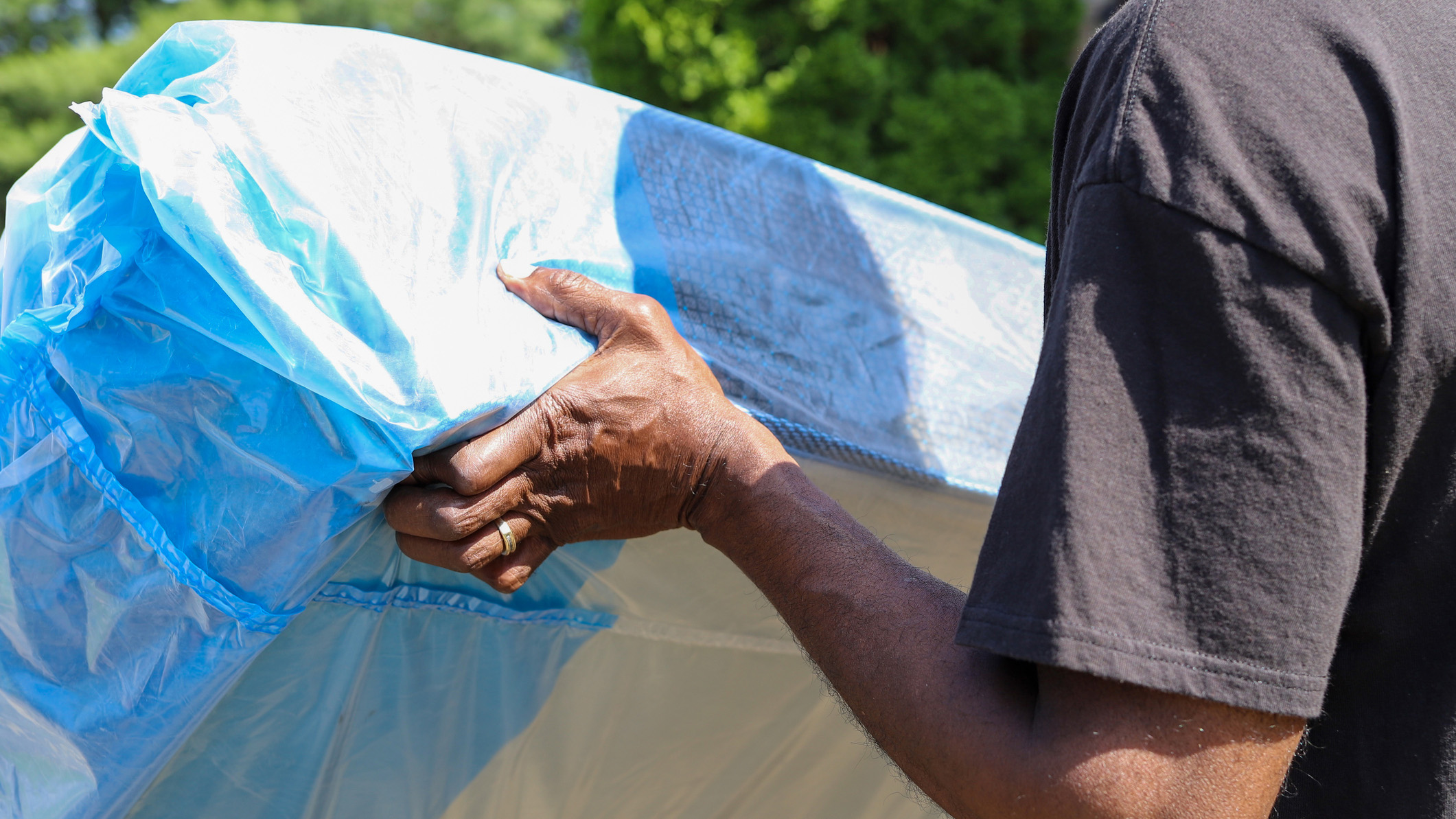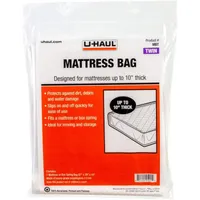How to cover a mattress and protect it from damage when moving house
Learn how to cover a mattress properly whether you're moving house or putting it in storage for a while

Moving house is exciting yet stressful, and you don’t want to add to that stress by damaging your mattress in transit. The best approach is to learn how to cover a mattress and move it safely to your new home, keeping it free of stains and rips along the way. That means learning about the different types of mattress covers and which one you need for your bed.
This is especially important if you have invested in the very best mattress for your sleep and body – and it's doubly important if your mattress is still within its sleep trial period. Why? Because if you change your mind about the bed and want to exchange or replace it further down the line, you won't be able to do that if it hasn't been covered properly and damaged during shipping.
Here's what you need to know about how to cover a mattress and move it safely to a new home, including the prep work you need to do before covering it.
Clean your mattress before you cover it
First things first, give your mattress a good clean. This ensures you’re not moving it with any dirt and marks on it and you're leaving any bacteria, mold, dust mites and (hopefully not) bed bugs behind.
Remove your sheets and mattress protector and wash them according to the manufacturers care instructions. Next, vacuum the mattress to get rid of any build-up of dead skin and dust mites. This is also a good time to look for signs of bed bugs in your mattress and take the appropriate steps to killing those pesky critters and fully sealing your mattress until all of the bed bugs have died. (Read more about this in our feature on how to prevent bed bugs getting into your mattress.)

You can deodorize a mattress by sprinkling it in baking soda and leaving it for a couple of hours before covering it. This will draw out any odours and generally make the mattress smell much nicer in your new home. Don’t forget to vacuum up the baking soda when you’ve finished and repeat on the other side of the mattress.
Finally, air your mattress near an open window with plenty of direct sunlight, as UV helps to kill mould and bacteria and is important part of how to clean a mattress to help it last longer.
Get instant access to breaking news, the hottest reviews, great deals and helpful tips.
How to cover a mattress for moving or storage
The very worst thing you can do is chuck a mattress into a removals van without any proper protection. Firstly, we’d recommend that you always have a mattress protector on your mattress. This will protect it from any stains and spillages. But if you haven’t got one, make sure to invest in one of our best mattress protector recommendations.
You should also invest in a heavy-duty mattress bag specifically for moving. These bags are made from thick, waterproof plastic and are low friction, meaning you can slide your mattress along in them without damaging it.
You can also buy them in different sizes to fit your mattress. Don't leave your mattress in the bag for too long at your new home though or it will start to get damp and could develop mold. Here's how to cover a mattress...
1. Buy a mattress bag for moving
These bags are very different to mattress protectors and should be sized to fit the mattress you're moving. These are normally basic plastic bags that slip over the entire mattress, keeping it protected on the top, bottom and sides. Cheaper mattress bags can be a little flimsy though, so if you have an expensive mattress, we'd recommend investing in a good quality mattress bag or even a hard mattress cover used to ship custom and handmade mattresses around the world.
Here are some examples of mattress bags for moving:
Pratt Retail Mattress Protection Bag: $16 at Home Depot
This basic plastic mattress bag is made from reusable plastic and will create a barrier around your mattress, safeguarding it against moisture, dirt and dust during moving. It comes in a range of standard mattress sizes and is ventilated to ensure good airflow around your mattress to prevent it smelling musty when you unpack it.
U-Haul Mattress Moving and Storage Bag: from $7.95 at Amazon
If you want an easy on and off mattress cover for moving that's also super-cheap, the U-Haul mattress bags are worth a look. They are basic 2mm plastic bags and may not withstand more than one use, but they're perfectly fine for covering a 10" mattress or smaller or a 10" box spring or smaller during transit or storage.
2. Ensure you have all mattress cover supplies
In addition to a proper mattress bag, you will need some strong packing tap to reinforce the bag and keep it secure at the top and corners. If your moving day is looking likely to be full of rain, or you're moving at a time of year when rain is more likely, look for waterproofing bags and tapes instead.
You'll also need to think about how you can move your mattress once covered into your van or other vehicle for transporting to your new home. A dolly or hand truck might be needed, for example, plus furniture sliders to help the mattress glide along any areas where lifting it proves tricky.
How to move a mattress safely
Moving any mattress (even a smaller size like a twin) is a two-person job. Firstly, mattresses are extremely heavy and moving one on your own could do you a fair amount of damage. Secondly though, mattresses have a tendency to flop about if only one person is supporting them. This means that strain can be put on the foam layers and springs, which could lead to damage on the mattress.

Remember when your mattress in a box arrived, all neatly vacuum packed into box? Well, it’s not going to go back in that box for transporting to a new home. If you’re using a removal company, they will obviously have vans and lorries to accommodate large items. But if you’re on a budget and hiring a van to move your belongings, do make sure it’s big enough to take a mattress.
Your mattress is likely to be on its side during transit. Make sure that it is up against the side of the van or lorry and that it has been secured with straps or wedges. If not properly secured, the springs and foams could be placed under too much strain.
What to do if your mattress gets damaged
If you follow all the above steps, your mattress should stay in one piece for its house move. But accidents do happen, so what should you do if your mattress gets damaged when moving?
Depending on the type of mattress you own, one of the first concerns is a fibreglass leak. Fibreglass is a synthetic material commonly used in wall insulation, but also found in cheaper mattresses and some memory foam mattresses. It’s often invisible to the naked eye and can be woven into mattress covers, all-foam beds and bed toppers as a budget flame retardant.
If your mattress cover is torn during shipping, leave it in its protective cover to limit fibreglass exposure. If you used a removal company to transport your mattress and they damage it in transit, make an insurance claim to put towards a replacement bed. There are plenty of monthly mattress sales to save you up to 50% on a range of beds, including the best hybrid mattresses, cooling beds and luxury organic mattresses. Some of our favorite sales are listed below.

Jo Plumridge is an experienced mattress reviewer with several years' experience covering all things mattresses and sleep, and who tests memory foam, hybrid and organic mattresses. What Jo doesn't know about a boxed mattress isn't worth knowing, so naturally we tasked her with producing a series of features for Tom's Guide looking at all aspects of mattresses, from how to pick between latex and memory foam (it's a tricky one), to the seven mistakes people make when buying a mattress for the first time. When testing the DreamCloud Luxury Hybrid for Tom's Guide, Jo said: "I loved the back support and pressure relief it offered. Plus, it looks far more expensive than it is." When she isn’t writing about sleep, Jo also writes extensively on interior design, home products and photography.


